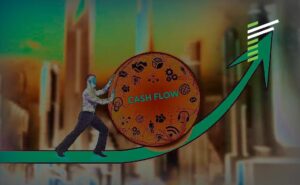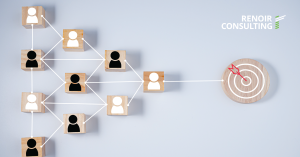At a Glance
Industrial manufacturer in India was facing underwhelming sales performance and operational inefficiencies across multiple states.
Key Result: Sales increased by 45.6% over baseline volume following strategic intervention.
This case study explores how Renoir Consulting implemented a robust sales transformation strategy, driving measurable improvements and sustainable change.
Key results
45.6% increase in overall sales performance.
11% improvement in daily field visits by junior sales staff.
Clear visibility and control over regional sales performance through structured planning.
Background
The client is a long-established manufacturer based in Eastern India, with decades of operational expertise and a strong footprint across the region. With a modern production facility and a large workforce, the client has consistently supplied high-volume products to the construction and infrastructure sectors.
Despite a strong production capability, the client struggled to translate this into consistent sales outcomes across its primary markets in eastern and northern regions.
Analysis
The project was initiated to address multiple sales-related challenges:
- Fragmented and uncoordinated sales efforts.
- Absence of a structured control system and clear performance metrics.
- Limited visibility into regional sales performance and individual accountability.
- Insufficient engagement with secondary customers and distribution channels.
- Underutilisation of field staff capacity due to lack of direction and monitoring.
The need for a strategic overhaul became evident to ensure the sales organisation could operate efficiently and meet market demand.
Project Approach
Renoir undertook a rigorous diagnostic phase to uncover root causes and performance gaps:
Historical Sales Review: Analysed six months of sales data across four states to identify performance trends.
Field Observations: Conducted “Day in the Life Of” studies to assess how frontline staff spent their time. Several key findings were captured across Hot Dip and Cold Dip Areas.
Customer Insight Surveys: Collected feedback from key customer groups to understand expectations and decision drivers.
Market Analysis: Mapped product segmentation and competitor positioning in target regions. This is to identify and comprehend the different types of products offered by the competitors in the Market.
Based on these insights, Renoir designed a comprehensive transformation plan focused on operational discipline, performance management, and strategic sales planning.
Ready for a change in your organisation?
Implementation
In partnership with the client, Renoir implemented a series of initiatives aimed at restructuring the sales function and embedding control mechanisms across the sales value chain. These actions involved coordinated efforts across multiple levels of the organisation—from senior leadership to frontline personnel—ensuring accountability, clarity, and efficiency in execution.
1. District-Level Business Planning
Monthly sales targets were developed at the district level, aligning distributor and dealer activity with broader sales goals. These plans, compiled by regional teams, formed the basis for operational alignment and performance tracking. Input from KROs (Key Relationship Officers) was instrumental in ensuring accurate demand forecasting.
2. Fabricator-Focused Sales Planning
To support secondary sales, Junior KROs were tasked with mapping and engaging local fabricators. A detailed monthly plan identified key fabricators for each territory, enabling targeted efforts to support dealer inventory movement. This micro-level planning improved stock liquidity and field-level execution.
3. Weekly Sales Reviews
The Sales Head, along with State Heads and the sales operations monitoring Team, conducted weekly reviews to assess dealer-wise performance, track sales vs. target, and resolve issues. These sessions played a central role in steering operational execution and ensuring alignment with district-level goals.
4. Daily Reporting by State Heads
State Heads were required to submit daily activity reports, capturing dealer order and dispatch status, stock positions, and unresolved issues. These updates ensured proactive support from central teams and faster issue resolution.
5. Market Visits by Sales Leadership
Bi-weekly field visits by the Sales Head enhanced visibility and engagement with both primary (dealers) and secondary (fabricators) customers. These visits provided direct insight into customer expectations, competitor actions, and field staff performance—particularly of Junior KROs.
6. Weekly Planning by Junior KROs
Each Junior KRO submitted a weekly report every Monday, outlining past performance, current inventory levels at assigned dealers, and upcoming engagement plans. These reports helped enforce accountability and facilitated close monitoring by KROs and the Udaan Team.
7. Field Visit Tracking by Sales Operations Monitoring Team
Sales Operations Monitoring Team conducted weekly performance checks, questioning Junior KROs on the number and quality of their visits, sales achievements, and action plans for pending targets. This mechanism ensured continuous tracking of field efforts and performance alignment.
8. Stakeholder Awareness Sessions
Structured meets with fabricators were held as needed to raise awareness, address concerns, and gather market intelligence. Standard operating procedures (SOPs) were developed to manage these events effectively, with State Heads responsible for execution.
9. Quarterly Training Programme
Every Junior KRO was enrolled in a quarterly training cycle focused on improving communication skills, product knowledge, market engagement, and strategic selling. These sessions fostered a culture of continuous improvement and learning.
10. Deployment of Sales Toolkits
To ensure consistent market presence, all field staff were equipped with standardised sales toolkits. These were refreshed quarterly and became an essential part of the Junior KRO’s professional engagement with customers.
Results
The outcomes of the transformation were substantial:
- Significant sales growth was recorded across key regions, with an uplift of 45.6% over the previous baseline.
- Field effectiveness improved, demonstrated by an 11% rise in average daily visits by junior sales personnel.
- Planning discipline became embedded across all levels of the sales team, from monthly forecasts to daily field execution.
- Leadership control improved, with consistent reporting and weekly reviews offering actionable insights and accountability.
- Customer engagement strengthened, supported by regular market visits and targeted outreach events.
- Employee capabilities were enhanced through structured training and regular feedback, laying the foundation for long-term growth.
*Client-specific details have been intentionally omitted to maintain strict discretion.
Let’s build a high-performing sales engine together.












